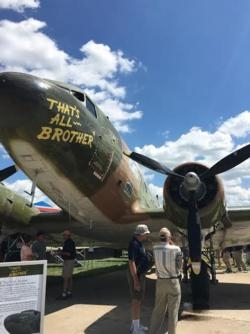That’s All, Brother Being Brought Back To Flying Condition By The Commemorative Air Force
By Maria Morrison
On June 6th of 1944, over thousands of aircraft, ships, and Allied troops made their way over the beach in Normandy France in the D-Day invasion. Early that morning, at 12:44, the first airplane crossed the shoreline to drop paratroopers behind enemy lines. That airplane was a C47, piloted by Lt. Col. John M. Donalson, dubbed 'That's All, Brother'.

After the war, The Douglas C47 Skytrain passed through several civilian owners before ending up at Basler Turbo Conversions, just across the field at KOSH. Slated to be cut apart in just weeks, the Commemorative Air Force learned about this historic airplane and quickly contacted Basler, quickly raising enough money to save it.
Established in 1957, the Commemorative Air Force (CAF) “has been, at its heart, a volunteer organization,” says Curator and Education Coordinator Keegan Chetwynd. It was began by ex-military men after WWII who wanted to preserve the original aircraft. After the war, the historic aircraft that had flown were being “scrapped on an industrial scale.” Now, the CAF has over 165 WWII aircraft, which are scattered around the country at over 60 units of the CAF, all of which keep the aircraft flying. This makes the CAF the largest flying museum in the world.
The mission of the CAF is to “find one of a kind WWII aircraft,” which is exactly what they did with That's All, Brother. When the C47 was found, the CAF was given a limited amount of time to raise enough money to save it. Using a Kickstarter fundraiser online, the CAF raised $328,000 in in 30 days. This was a “clear mandate from the American people that they like what we [the CAF] are doing.”
Now, over $1.1 million has been donated towards the aircraft. With a projected $1.7 million more required, the CAF hopes to have That's All, Brother ready to fly at AirVenture 2017, and fly over Normandy in 2019 for the 75th DDay anniversary. The money is needed to fix the deep structural damage done to the aircraft over the years. Moisture accumulated in fabric in the tail, causing lots of corrosion in the tail area. “We really feel that this airplane will still be flying in 50 years, 100 years, 150 years, for people to enjoy.”
The CAF prides itself on making its restored aircraft to a 100% original, exactly how it would have been in the war. “You know how invasion stripes were painted with mops?” asks Chetwynd, “We’re going to paint the invasion stripes with a mop.” This goes along with the CAF’s mission to show upcoming generations of Americans why they should be proud of their country. “We create programs that help people understand what was done for them to grow up in a free country... THe greatest generation should inspire us to overcome our daily challenges.”
That’s All, Brother will be part of a youth education program, helping the public get past the “inherent coolness” of the aircraft and “gain a deeper appreciation and understanding”. “Our goal is to inspire him,” Chetwynd ends, pointing to a young boy at the booth, “not to be a pilot, but to show him that you can be whatever you want. The people that flew this airplane were farm boys from Iowa, airplanes were the farthest things from them. WWII was a story, yes of what a nation can achieve when it works together, but also what you personally can achieve.”
That’s All, Brother, which led over 800 aircraft in the first wave of the DDay invasion, is on display at show center at AirVenture. It dropped the first of 13100 paratroopers that day. As it was passed along, its historical significance was slowly forgotten. “Not that the plane itself was lost, but the history was unknown.”
(Staff image)
 ANN's Daily Aero-Term (04.20.24): Light Gun
ANN's Daily Aero-Term (04.20.24): Light Gun Aero-News: Quote of the Day (04.20.24)
Aero-News: Quote of the Day (04.20.24) ANN's Daily Aero-Linx (04.21.24)
ANN's Daily Aero-Linx (04.21.24) Aero-News: Quote of the Day (04.21.24)
Aero-News: Quote of the Day (04.21.24) ANN's Daily Aero-Term (04.21.24): Aircraft Conflict
ANN's Daily Aero-Term (04.21.24): Aircraft Conflict



